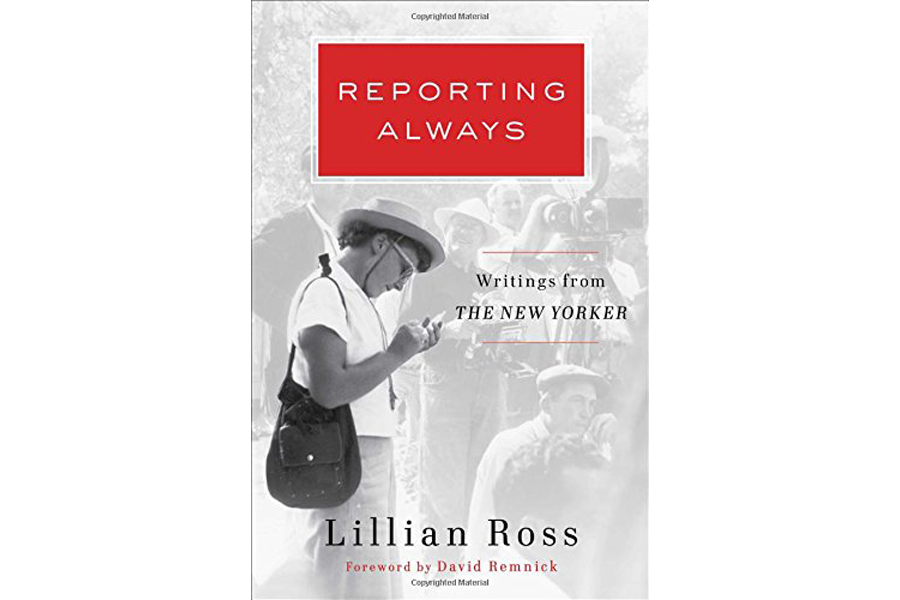'Reporting Always' showcases the work of New Yorker giant Lillian Ross
Loading...
If you are reading the Monitor's books pages, you likely already know that The New Yorker is a giant in the field of narrative nonfiction. But unlike like the wild personas of New Journalism writers like Tom Wolfe and Norman Mailer, today's New Yorker writers – like Katherine Boo, Atul Gawande, Peter Hessler, and Susan Orleans – combine reporting with more subtle literary techniques to tell true stories that carry the momentum of fiction.
Gawande weaves these stories from US hospitals and the front lines of medicine; Hessler from rural China, the hutong, or alleyways, of Beijing and now Cairo; Boo from poverty-racked neighborhoods in Louisiana or India. Each rallies meticulous details, an ear for dialogue and voice, an eye for setting, and a literary sense of irony, humor, and tragedy, to take us on real-world but nonetheless breathtaking narrative journeys.
Lillian Ross, who began as a staff writer at The New Yorker in 1945, could in some cases be their grandmother, and in many ways she is the grandmother of exactly this brand of narrative nonfiction. Possibly Ross – who since 1945 has covered everything from legendary writers, actors and directors, to nameless school kids, bull fighters, and beauty pageant contestants – started it all.
And she's done so with a beautiful gratitude, judging from the pages of her own intro, which is one of the jewels of Reporting Always, a new collection of key Ross pieces for The New Yorker.
She's grateful, Ross says, for the opportunity her writing has given her to "have my little say about what I have found going on in our time." She calls it a privilege, and one wishes that all journalists felt that weight of privilege and responsibility in depicting the stories of their fellow humans.
Referring to her "magical use of facts," New Yorker editor David Remnick in his own intro to this collection, sets out right away the idea, a reflection of the book's title, that key to Ross's storytelling is her commitment to journalism.
And this is a grand quality to highlight: While readers and lovers of long-form nonfiction have long celebrated the creative talent involved in roller-coaster storytelling – think the talented Michael Lewis, the late Hunter S. Thompson, most Rolling Stone profiles – it's wonderful to stop to appreciate the subdued but artful narrative that emerges from Ross's slow, subdued unfolding of a personality, a place, a milieu, or a phenomenon, or all of the above at once.
In the 1954 piece "The Big Stone," Ross writes entire paragraphs consisting of suited men looking at and talking about diamonds. Because they themselves – as depicted by Ross – are overwhelmed by this process, we follow along and are drawn into it. And even a straightforward passage of Ross’s like this one – "Ludel sat down at a table near a window facing north over the roofs of several fine old Georgian houses. He put a loupe to his eye and looked at the diamond through it" – can be embedded with suspense.
But while Ross is dedicated to reporting – to teasing out the truth of a character, a setting, or situation – also on full display here are the stunning, if quieter, literary and storytelling techniques that inform her work.
Even in the sentence above with its "fine old Georgian houses,” one can glimpse the relentless harvesting of details sewn into Ross's depictions, providing a slow, cinematic unfolding that powers her narratives. Maybe the examples are from Composition 101: She shows, not tells; she paints a picture, sets a scene. They sound like cliches, but Ross may have invented the form.
"I enjoyed showing everything using dialogue and action, with no authorial intrusions and no presumptions about what was going on inside the subject's head," writes Ross in her own intro to this collection. She also refers to this method as "writing a piece as if it were a miniature movie" – and the resulting stories are a grand combination of the cinematic combined with a journalist's respect for verifiable facts.
Possibly the most striking example of this combination comes not from the exhilarating reads about the rich and famous, but from the simple, haunting descriptions of stories like "The Yellow Bus," which describes a school trip that brings a class of rural Indiana high school seniors to Manhattan for a weekend. Through detailed descriptions and dialogue, the short piece delves into the dreams, disappointments, and minor transformations of a group of young people on the brink of adulthood.
But the most astonishing part of the article is an unexpected literary technique – the assuming of the point of view of the yellow bus that carries the kids into this new alien world: "A few Sunday's ago, in the late afternoon, a bright yellow school bus ... emerged into New York City from the Holland Tunnel." At the end of the article, the same bus – a few days, and a few awakened dreams later – carries the teens into their future, heading "west over the George Washington Bridge" where it "disappear[s] from the city."
That frame, giving us the story from the point of view of a bright-yellow bus, carrying the teens and their fears and imaginings, or lack thereof, is that of not only a writer, but also a journalist, a cinematographer, and a thoughtful conveyor of human stories for our time. She’s having her "own little say,” but in rather a big way.








